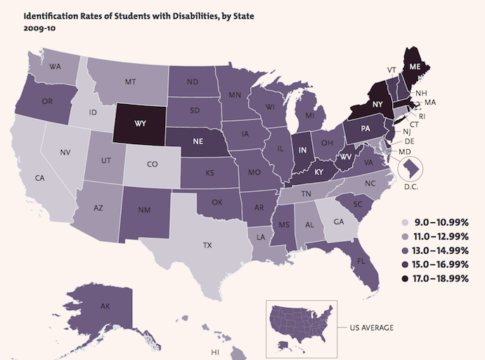A few weeks ago, we at Fordham released a short analysis, Shifting Trends in Special Education. We noticed that some states, like Massachusetts and New York, identified almost twice as many students as needing special education as those in other states, like Texas and California. We tried to make sense of these findings but noted that we couldn’t find any statistically significant relationship between the demographics of a state and its special ed ID rate. In particular, the poverty rate of a state didn’t seem to matter; some poor states have high ID rates, other have low ones, and others are in between. Same with rich states.
Still, I couldn’t help but wonder if school spending (adjusted for cost of living) was driving the differences. After all, you don’t have to be a rocket scientist to notice that Massachusetts and New York spend a ton of money on their schools and California—similar to them in so many other ways—spends a fraction as much.* Perhaps a sense of scarcity in resource-starved states like California encourages school districts to avoid identifying lots of kids for pricey special education services.
So I asked our new research intern (and Koch Fellow) Josh Pierson to run a regression and here’s what he found:

I then asked my friend Marty West, assistant professor at the Harvard Graduate School of Education, to interpret the findings. He wrote:
The correlation between adjusted per pupil spending and ID rates is 0.37 (and highly statistically significant), which means that the relationship can account for 13 percent of the total variation in ID rates. If you look at it in a regression framework, you learn that a one thousand dollar increase in spending is associated with a 0.36 percentage point increase in ID rates. The relationship appears to be fairly linear and does not appear to be driven by outliers (i.e., one or two states with odd data). And weighting the states by their enrollment (so that California contributes more to the estimation than Wyoming) makes the relationship a bit stronger. Finally, controlling for your adjusted household-income variable strengthens the relationship (so that a one thousand dollar increase in ID rates gives you a 0.77 percentage point increase in ID rates). You also see that, controlling for spending, incomes are negatively related to ID rates.
He continues with a warning:
There’s clearly a statistical relationship here, but it is hard to know what to make of it in terms of substance. It could be that better-resourced systems identify more kids because they have the capacity to serve them separately, but even if that were the case there is a lot of variation that it can’t explain (look at Rhode Island and Texas, for example). I think you need to be very careful in how you interpret these data.
I agree; it’s hard to know what to make of these data. But it’s certainly possible that “better-resourced” systems are more willing to identify more students for special-education services. Whether that means that high-spending states are over-identifying kids—or that low-spending states are under-identifying them—is impossible to know, at least from these data. But at least we now have a plausible explanation for the big state-by-state variation. And I can’t help but wonder whether the “New Normal” (most states finding resources much more limited) will drive down identification rates at a fast pace.
Other interpretations?
* I was surprised to learn from the chart above that, after adjusting for cost of living, Massachusetts and New York don’t actually spend all that much money, and Texas is far from stingy. But look at California. Yikes.
-Mike Petrilli




